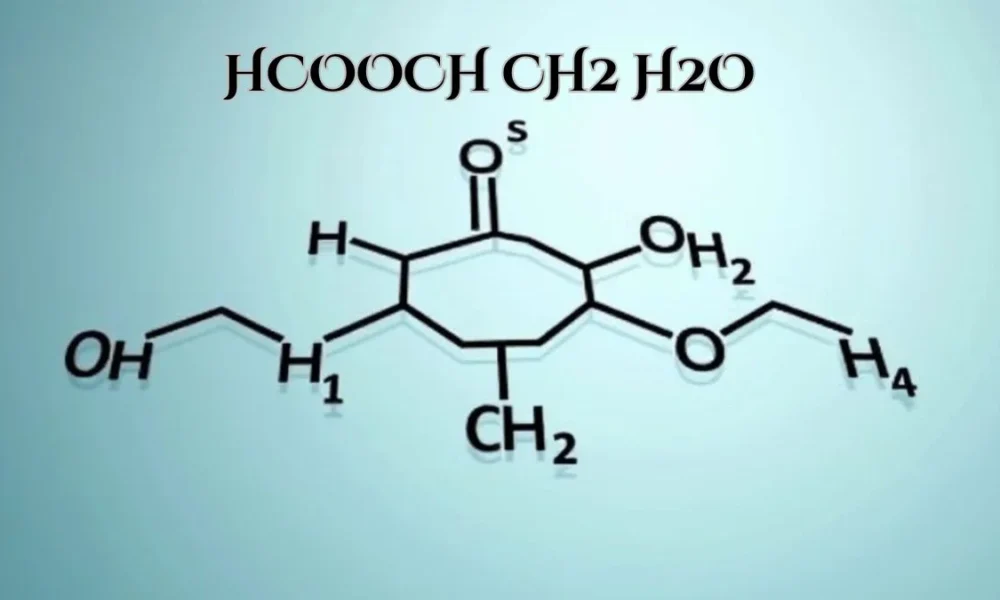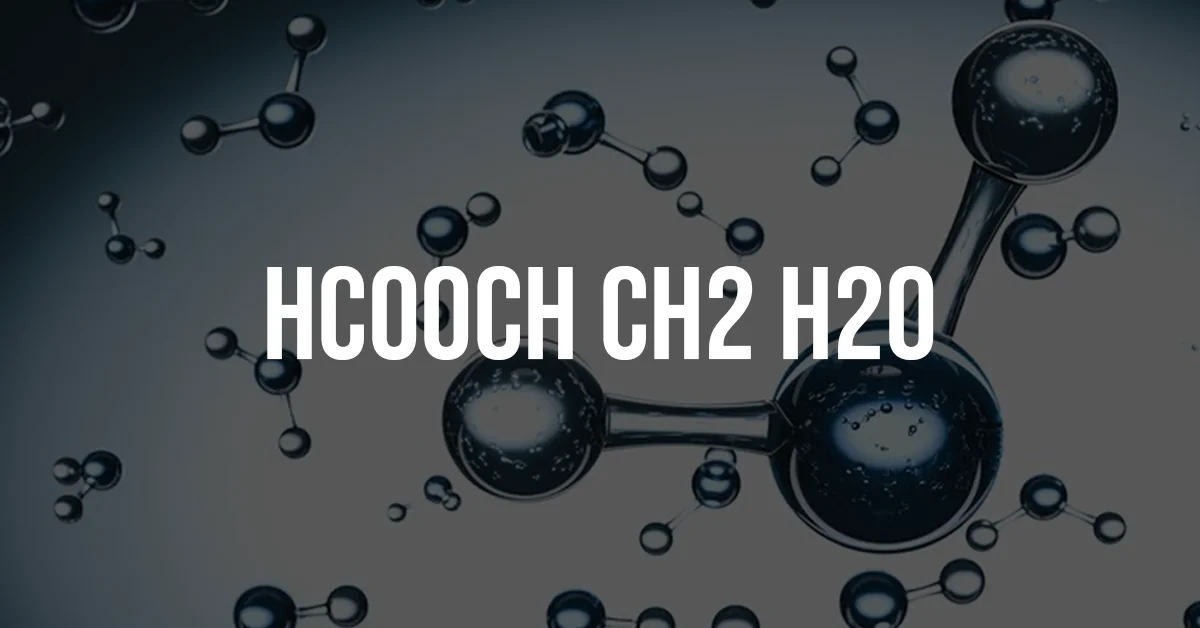Among the myriad of compounds explored by scientists in modern chemistry, Hcooch Ch2 H2O has emerged as a particularly intriguing molecule. First synthesized in the early 21st century, this reagent attracted attention for its unusual combination of a formyl group, a methylene bridge, and a hydroxyl terminus—all within a single backbone. Its nomenclature reflects classical organic notation, yet its behavior defies simple analogies to formic acid or methanol. Today, advanced catalytic methods enable gram-scale preparation, and interdisciplinary teams investigate its potential across sustainable energy, materials science, and pharmaceutical development. This article provides a comprehensive overview of its molecular architecture, industrial utility, environmental profile, ongoing research frontiers, pedagogical value, and essential safety guidelines.

At its core, Hcooch Ch2 H2O features an unconventional arrangement of atoms that challenges textbook bonding paradigms. A formyl (–CHO) group links via a methylene (–CH₂–) spacer to a terminal hydroxyl (–OH), creating an internal polar axis. Infrared spectroscopy reveals a strong carbonyl stretch near 1720 cm⁻¹ alongside an O–H stretching band around 3450 cm⁻¹, indicating both electrophilic and hydrogen-bonding character. Nuclear magnetic resonance (NMR) studies show the formyl proton at δ 8.3 ppm, while computational density functional theory (DFT) calculates a dipole moment exceeding 3 Debye. Conformational analyses suggest transient intramolecular hydrogen bonds in protic solvents, which can modulate reactivity and solubility. Thermal gravimetric measurements place its melting point at 48 °C, with decomposition onset around 190 °C, underscoring the need for controlled storage. Compared to simpler analogues, this compound’s steric and electronic subtleties foster reactivity pathways unobtainable in classic reagents.
In the industrial realm, Hcooch Ch2 H2O serves as an indispensable intermediate for specialty chemicals and active pharmaceutical ingredients. Its formyl functionality enables selective condensations with amines and alcohols to yield heterocycles, imines, and acetal derivatives under mild, catalyst-mediated conditions. The –OH terminus enhances compatibility with aqueous-phase reactions and simplifies extraction protocols. In polymer chemistry, this molecule acts as a di-functional monomer to produce novel polyesters that exhibit exceptional tensile strength and thermal resilience. Agrochemical formulators incorporate it into soil additives, where it improves micronutrient delivery efficiency and reduces leaching losses. Fragrance houses exploit subtle derivatives to craft long-lasting scents with diminished allergenic profiles. Recent pilot-plant data demonstrate over 95 % yield in a continuous-flow synthesis, with solvent recovery rates above 90 %, aligning with green-chemistry principles by minimizing waste and energy consumption.

Debates have arisen regarding the ecological footprint of Hcooch Ch2 H2O, with concerns about persistence and toxicity in aquatic ecosystems. Contrary to alarmist views, comprehensive biodegradation assays indicate half-lives of less than five days under aerobic conditions, ensuring rapid clearance in wastewater treatment facilities. Ecotoxicological evaluations show negligible chronic effects on algae, daphnia, and fish at concentrations up to 50 mg/L. Life-cycle assessments of industrial processes incorporating this reagent reveal lower greenhouse-gas emissions than alternative solvents, largely due to efficient catalytic turnover and closed-loop recovery systems. Regulatory bodies currently classify it as low hazard, provided that effluents undergo standard tertiary treatment. Continued monitoring and adherence to discharge guidelines safeguard against unintended environmental accumulation.
The scientific community is actively pursuing novel derivatives and analogues of Hcooch Ch2 H2O to expand its utility. Heterogeneous catalysts have been engineered to harness its formyl unit for carbon–carbon coupling, enabling streamlined synthesis of pharmaceuticals and agrochemicals. Material scientists embed it within metal–organic frameworks to enhance gas-storage capacities and selective separations, promising advances in carbon capture. Photochemical investigations use its chromophoric attributes to mediate visible-light-driven transformations, paving the way for solar-powered fine-chemical production. Additionally, machine-learning algorithms, trained on reaction datasets involving this substrate, predict optimal conditions and reduce discovery timelines. Such interdisciplinary approaches signal a bright future where this molecule underpins sustainable and efficient chemical manufacturing.

Educators seeking hands-on, real-world chemistry modules can leverage Hcooch Ch2 H2O to teach foundational and advanced concepts. A straightforward acid–base titration quantifies its formyl proton acidity, while UV–Vis spectrophotometry monitors hydration-dehydration equilibria. More elaborate exercises task students with synthesizing a methyl ester derivative, tracking conversion via thin-layer chromatography and gas chromatography–mass spectrometry (GC-MS). By varying catalysts and solvents, learners explore kinetics, mechanism, and green metrics such as E-factor. Safety training emphasizes interpreting material-safety data sheets, handling volatile organics, and implementing proper waste segregation. These multidisciplinary experiments foster critical thinking, analytical skills, and laboratory best practices, preparing students for professional research environments.
While moderately stable, Hcooch Ch2 H2O demands strict safety protocols to mitigate reactive hazards. Laboratory personnel must consult the material-safety data sheet for specific information on flammability, acute toxicity, and permissible exposure limits. Recommended precautions include wearing chemical-resistant gloves, safety goggles, and lab coats, and conducting all manipulations within a certified fume hood. In case of spills, absorbents compatible with organic liquids should be deployed, and contaminated materials disposed as hazardous waste. Storage requires sealed, amber-glass containers at temperatures below 25 °C, away from strong oxidizers and bases. Regular training refreshers and adherence to institutional waste-management guidelines ensure responsible handling and regulatory compliance.
In summary, the multifaceted nature of this molecule underscores its importance across research, industrial, educational, and environmental contexts. By understanding its unique structure, leveraging its versatile applications, addressing sustainability considerations, and adhering to safety best practices, scientists and engineers can unlock the full potential of this remarkable compound. Continuous innovation and cross-disciplinary collaboration will undoubtedly reveal new horizons for chemical science and technology in the years to come.

